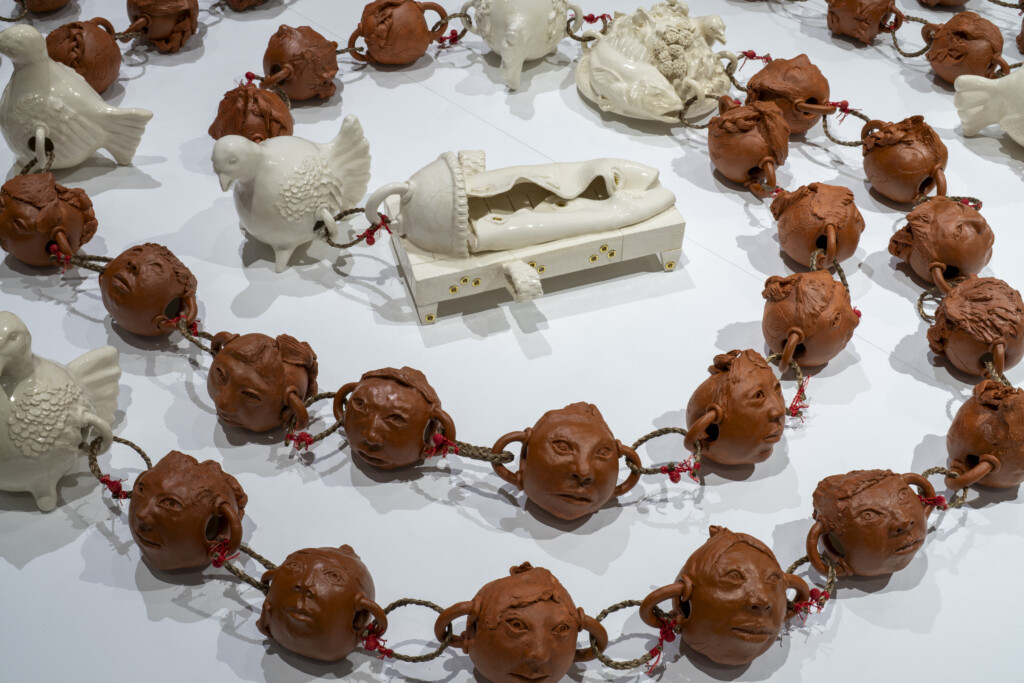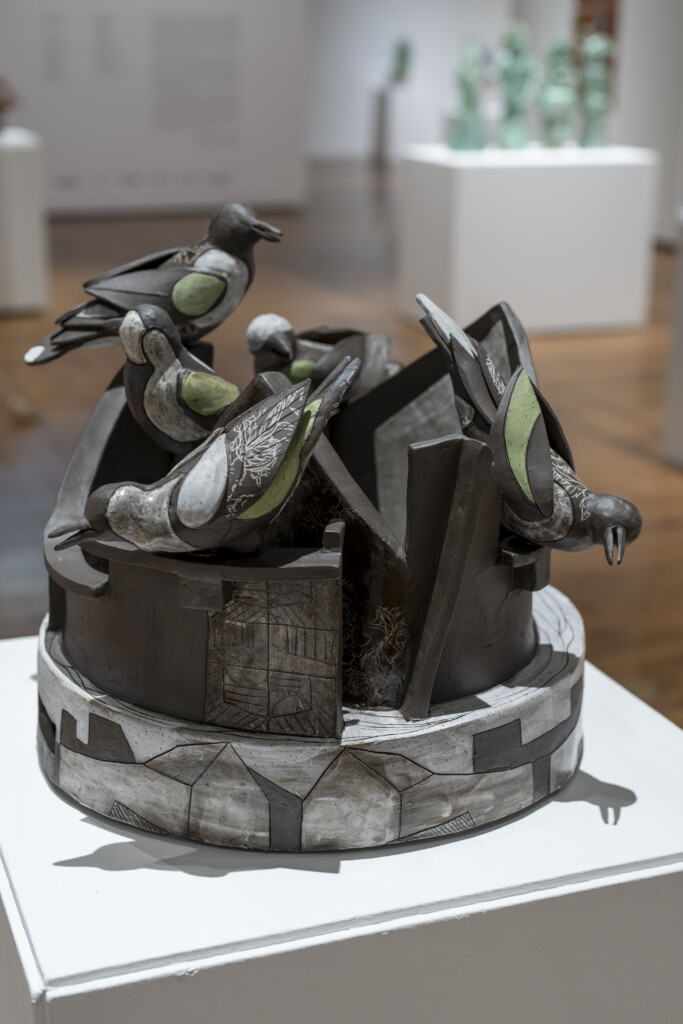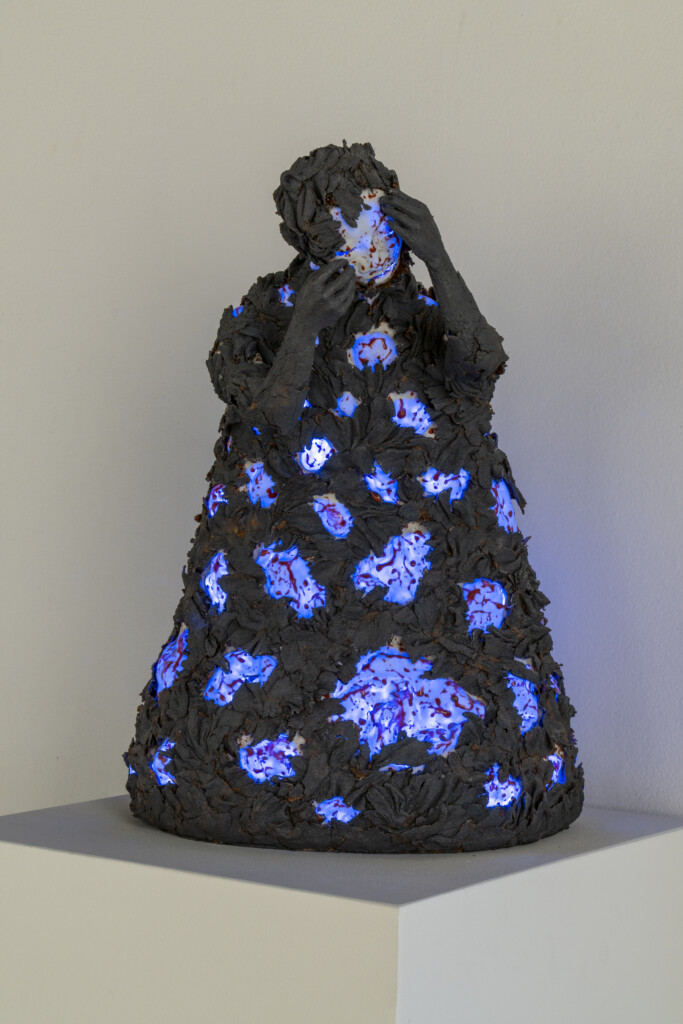EDITOR’S NOTE: Numeorus local art events are associated this week with the National Council on Education for the Ceramic Arts (NCECA)’s 59th conference which is being held in Salt Lake City. The Utah Museum of Contemporary Art (UMOCA) is home to NCECA’s three cornerstone exhibitions. Also, Material Gallery is hosting an exhibition Form (in)Formation: see this link for a feature about this show.
This week, more than 6,000 attendees have registered for National Council on Education for the Ceramic Arts (NCECA) and several major exhibitions representing the expansive creative possibilities of ceramics have been installed in Salt Lake City.
For the first time in the organization’s history, NCECA’s three cornerstone exhibitions have been installed in a single museum. The Utah Museum of Contemporary Art (UMOCA) is the host of the 2025 NCECA Annual: True and Real, the 2025 NCECA Juried Student Exhibition, and the Multicultural Fellowship Exhibition, UMOCA is adjacent to the Salt Lake Palace Convention Center, where the conference is taking place. The good news is that these exhibitions will be open to the public, with two scheduled to be available through the end of May (True and Real, the juried students’ show) and the third through May 3 (Multicultural Fellowship).

sweetgrass, mixed media, 14″ x 84″ x 96″
Collectively, the three shows are the most impressive showing of contemporary American ceramics art ever presented in Salt Lake City. True and Real features the work of 40 artists, including invited artists Simone Leigh, Syd Carpenter, Roberto Lugo, Tip Toland, and Steven Young Lee. Curated by Judith S. Schwartz, this showcase examines the relationship between material, process, and personal truth in contemporary ceramic art. In terms of experimental approaches for using ceramics as a medium for narrative, the 2025 NCECA Juried Student Exhibition, co-juried by Adrienne Eliades and Nicole Seisler, highlights the next generation of ceramic artists. Just as enterprising is the Multicultural Fellowship Exhibition, juried by Jennifer Ling Datchuk, which highlights diverse voices shaping the future of the medium.
The artworks earnestly reflect the catalog statement by Joshua Green. NCECA’s executive director. “Ceramic art continuously evolves by cultivating deeply ingrained skills and ineffable understanding of natural resources, elemental forces, and changing technologies,” he said. “Artists strive to draw nuances embodied within their materials to the surfaces of their work. This process occurs through a dual commitment to repetitive practice and sometimes risk and experimentation.”
For museum visitors, whatever conventional perceptions one may have had about ceramics, the panoply of art curated in these NCECA exhibitions testify to ceramics’ versatility in capturing emotion, narrative and spiritual intelligence “Whether plotted in detail or improvisationally, this interplay of materials, process, and experimentation,” Green added. “the pursuit almost always strives to bring inner truths and realizations into the light of public experience.”
“Like NCECA, we are deeply committed to supporting and investing in our community of artists, makers, educators, and students,” Jared Steffensen, curator of UMOCA exhibitons, said. “The selections for these exhibitions reflect the depth and breadth of contemporary ceramic art and underscore the material’s ability to convey meaning in profound ways.”

14″ x 19″ x 14″
For more information, see the UMOCA website.
The Utah Review presents highlights from each of the the shows:
True and Real
Curated by Judith Schwartz, True and Real encompasses 40 works selected from more than 600 submissions. “The process reinforced and provided renewed evidence that the devices of irony, parody, obscenity, erotica, introspection, violence, dream imagery, metaphor, and the surreal continue to be vital in conveying ideas,” Schwartz wrote. “The voices were unapologetic and articulated, asserting that the social condition is an intrinsic element of personal and cultural discourse as they unabashedly spoke to the true and real.” The mixed media elements are prominent, with sculpture, painting, installation and video incorporated in many works.
An exceptional example is Constant Albertson’s Inter Caetera: Old Sins Cast a Long Shadow, a mixed media piece including earthenware clays and sweetgrass. The piece’s title references the Catholic Church’s efforts during the New World exploration to remove the presence of Indigenous peoples. The work is drawn from the the horrific legacy of federal Indian residential and boarding schools in North America, many of which were operated by the Roman Catholic Church. For instance, the discovery of unmarked graves, and details of infanticide and physical and sexual abuse at these boarding schools were chronicled in Sugarcane, a documentary film that was one of this year”s Academy Awards.
Albertson’s piece is fashioned like the rosary and its beads, which feature faces like those in archived photographs of Indigenous children who were placed in these schools. “This piece involved discussions with Indigenous leaders, archival image research, survivor testimonies, and material gathering,” the artist said, adding, sweetgrass was harvested and braided under the supervision of Indigenous artists.
Syd Carpenter’s stoneware piece Laurie Mason is an ode to the practices of African-American gardening and farming. While the artist starts with sketches, they are eventually discarded. The artwork’s sturdy and robust character is the result of working with clay with fired and unfired materials for the surfaces. “Coiled, press-molded, slab-built, wheel-thrown, and found objects are all employed to construct my pieces,” Carpenter explained. “The scale of my works is intended to express the robust, deceivingly powerful force within the growing tendrils, stalks, and branches.”
The show includes works by some of the most familiar names in ceramic arts. Among them is Roberto Lugo and his glazed stoneware vase Prison Sequence is stunning for how it introduces voices, imagery and representation that have been rarely, if ever, found in the historical canon of gallery work. At first glimpse, the vase seems like a vestige of classical antiquity but on close inspection. Lugo’s astute social anthropological context rivets the viewer’s attention to the multigenerational litany of racial injustices while showing the cultural resilience of African American and Latino heritages.
The vivid sociopolitical thematic expression comes through impressively in Insurrection by Kyle and Kelly Phelps. The 2023 mixed media artwork of wood, cloth, stoneware clay and paint captures recent moments of dark confluence in American history that continue to reverberate with the most unsettling and dire results and threats to the integrity of true ideals of democracy, if we are to ever eradicate discrimination, harassment and marginalized.

The sculpted death mask of a lion’s head is created with extraordinary depth of detail in Lindsay Pichaske’s Souvenir, comprising stoneware, porcelain, mason stains and hair. “The multiple parts were made by solid sculpting with stoneware clay, then hollowing, and covering the head and mane with strips of pigmented porcelain that follow an abstract pattern, and my hands were thus integral to every step of the process,” Pichaske explained. “In this age of new technologies, I believe it is more important than ever to have a physical connection to material and the hand.”

Natural science is at the heart of several artworks in NCECA exhibitions. Lydia C. Thompson’s Bird Formation #3 emerges from her research of bird migration and the interactions with glass and spaces resulting from the presence of humans. But, the idea of migration in Thompson’s work is expanded to its parallels in the migration history of Black people. Furthermore, she draws attention to the fact that not everyone can enjoy the simple pleasures of birdwatching without fearing resistance or tensions of facial profiling. She cites a story that gained national media attention: “Christian Cooper, a Black man interested in bird-watching [was] racially profiled by a white woman in Central Park. Despite progress in race relations, I wish to keep social justice at the forefront of the world’s perspective as we race to save natural resources.”

Known for her award-winning hyper-realistic ceramic sculptures, Tip Toland‘s Enough is autobiographical but universal. Now in her mid-seventies, Toland wrote, “The characters are always part of a narrative. Often, but not always the narrative acts as a metaphor related to my inner world. The title, gesture, facial expression, coloration, hair and, often a prop, are windows into the story. I hope the viewer sees the entire piece as one moment frozen in time.”
Exquisite in detail and form, Judit Varga’s Empty Yellow Pod comprises multiple-fired, low- and high-fired porcelain and colored stoneware with vitrified slips. The fragility and impermanence of life, nature, and homeland are expressed poignantly here. “Empty Yellow Pod is holding my fears for a future when everything dissolves into an artificial existence,” she explained, adding, “feelings are emptied and mute, replaced by addiction to a virtual reality where nothing is TRUE or REAL anymore.”

Multicultural Fellowship Exhibition
Juried by Jennifer Ling Datchuk, the exhibition reflects a spectrum of emotional expression. “I was deeply affected by how their narratives were explored through the variety of forms like overly adorned vessels, figurative works, and abstracted forms, and the investigations with materials and techniques explored through video and wall work,” Datchuk wrote. Their works become important reflections of representation, what stories we tell, and the world we want to see.”
Among the works featured is Tomo Ingalls’ My Tea Party, made of earthenware, terra sigillata and cone 04 oxidation. Instead of figures, Ingalls capitalizes on clay’s malleable properties to bend and twist body parts that produces lucid dynamics about our capacities for nonverbal communication for how they not only inform and champion individual identity but also the ways in which we interact and relate to others.
Sepideh Kalani’s ceramic sculptures reflect her experiences as an Iranian and what she has observed in her homeland since the Islamic Revolution in 1979. After the Sandstorm signifies how she weaves in elements of Islamic architecture, Qajar dynasty figures (1848–1896), influences, and contemporary themes. “My sculptures reflect solitude and universal fears and evoke empathy, questioning identity and values, particularly as a woman,” Kalani wrote.
Kim Le’s Eat the Colonizer is a brilliant commentary on sociopolitical history. A second-generation Vietnamese American, Le wrote, “I feel like my Vietnamese-ness is secondhand. Passed down from my family’s continuation of habits and lingering nostalgia, I inherited a love for sour-smelling fish sauce and pungent durian.” The artist noted, ”There is a disconnect between the first and second generation of Vietnamese Americans. It’s confusing being naive yet prideful of my culture. Through my work, I bridge this gap between us by acknowledging aspects of my Vietnamese and American experience – consequently, a product of the Vietnam War.” The sculpted vase is a celebration cake but with a wedge removed that is served on a plate and a serving knife. The interior of the ‘cake’ contains a receipt of the enormous costs of war and loss of life.
Vanna Ramirez’s Hiding, a piece of stoneware and porcelain, includes an internal LED component. Born in the States and with Taiwanese and Salvadoran heritage, her work epitomizes the holistic experiences of many Americans who have rich, complex identities that defy categorization, reduction or compression.
Among the most prominent abstract pieces in the NCECA a exhibitions, Bianca Turner‘s Untitled # 16 (Red Sphere) is awe-inspiring in its intricacy. “Using coil building and pinch pot techniques, I push traditional ceramic boundaries, employing color to reflect diverse influences,” she wrote. “These pieces echo the freedom and challenges of alternative musicians, evolving from closed forms to more exposed, self-expressive works.”
Juried Students’ Exhibition
Hundreds of submissions came in for the student exhbitions, but jurors Adrienne Eliades and Nicole Seisler picked works from 23 artists currently in school. “Most chosen works use the lens of the personal to engage with larger social, cultural, or political issues, “ they wrote in a joint statement. “We feel strongly that more critical voices are needed in the ceramics field, and we were particularly inspired by works that embody those voices. Students today are using the traditions of ceramics to bolster new approaches and explorations of the language of clay.”
Alondra Cruz‘s La Lotería: Juego De Suerte is an outstanding take on the far more visually engaging and intellectually stimulating Mexican version of American bingo. Cruz incorporates the classic elements of street food, cultural tropes and icons in this assorted deck of Lotería cards. “My work reflects my journey of self-discovery and pays tribute to the resilience of the communities that have shaped me, “ she wrote.
Jinblossom Kim Plati’s Scholar Tree is stunning in its meticulous execution as an emblematic statement of her Korean heritage as well as elements of Western and Victorian inspirations. “Drawing inspiration from my father’s collection of scholar rocks, I draw a parallel between his artful rocks and my creative process. He carefully nudged and coaxed each scholar rock into its designated place on a bespoke wooden base,” she wrote. LI delicately positioned clay rocks on ceramic Victorian bases, creating a tangible connection between past and present.”

Alyssa Zavocki‘s Collective Consciousness: A Labor of Love skillfully fuses ceramics and the idea of quilt making in exploring and comprehending the infinite number of expressive layers of the female experience. “Quilts are inherently narrative; each fabric weaves its own story simultaneously, which helps to tell the story of the work as a whole,” Zavocki explained. “Femininity has been typically expressed as impressionable and permeable, molding itself to the needs of society at the time. Through clay and quilt patterns, I explore the interplay between my experience with femininity and the women who came before me.”









